How can we master the art of content with effective analytical insight?
A guide for those responsible for making strategic, operational and analytical decisions in business.
This guide to mastering the art of content with effective analytical insight comes with insights from professionals in the business, retail, construction and research sectors. They kindly lent their time to a discussion in July 2023 as part of our roundtable series at CDS headquarters in Leeds. Attendees explored the hidden depths of expertly created and well-curated content.
Our guide offers actionable tips for stakeholders to identify and explore the depth of analysis and thinking that supports the creation of remarkable content and how to transform analytical insights into practical, measurable improvements.

Executive summary
Content has become the lifeblood of successful businesses. It encompasses the stories we tell, the messages we convey, and the experiences we create for our audiences. Its influence extends beyond mere communication, shaping brand perception, driving customer engagement, and fuelling business growth.
But, mastering the art of content requires more than just creative prowess. As content professionals, it requires us to delve beyond the surface to look at the analytical framework that often remains concealed. It demands a strategic approach powered by data-driven decisions, expert planning and delivery, and the development of user-centred information architecture. Only then can we create remarkable content that delivers a seamless experience for our audiences.
What is content?
Content refers to any form of information, media, or communication created and shared to deliver value, engage an audience, and fulfil a specific purpose. It encompasses written articles, blog posts, social media updates, videos, images, podcasts, and more.
What makes ‘good’ content?
Effective content is strategically crafted to resonate with its intended audience, evoke emotions, provide solutions, and ultimately achieve specific goals within a broader marketing or communication strategy.
Therefore, content should be:
Findable
Ensuring users can easily locate it through navigation and search with a search-optimised information architecture. Balancing SEO value and relevance to page content is crucial, as conflicts may arise when stakeholders hold different views. Striking the right balance is necessary to ensure that content is both findable and relevant.
Clear
It must be purposefully designed, leaving no room for user confusion or unanswered questions. Avoiding jargon is essential as it can alienate stakeholders, making the use of plain and accessible language vital for understanding and instilling confidence in users.
Connected
Content must be meticulously designed to seamlessly integrate all related pieces into a cohesive and consistent whole that can be maintained over time. This holistic approach reduces the cognitive burden on audiences and fosters a continuous journey of engagement with the brand, even through indirect channels.
Human
It is crucial to prioritise the human aspect, ensuring empathy and respect for diverse human conditions and states. Content should be accessible and inclusive, catering to individuals of all abilities, engaging the user.
Helpful
Content should be relevant, informative, and actionable, empowering users to take immediate steps. It should be thoughtfully designed to facilitate user productivity and enable them to accomplish tasks efficiently. Content which aligns with user needs and provides clear instructions or calls to action can inspire users to take the next step.
Anna Sampson
Head of Content, CDS

How can we use AI for content creation?
AI is revolutionising the field of content creation by offering unprecedented opportunities and efficiencies. With AI-powered tools, businesses can automate various aspects of content creation, including generating written articles, creating personalised recommendations, and optimising content for search engines. AI can analyse vast amounts of data, identify trends, and predict user preferences, enabling companies to deliver highly targeted and engaging content to their audiences.
It provides an invaluable advantage when it comes to managing consistency and leveraging technology to our benefit. While our role as content creators will always involve creativity and understanding the audience connection, AI can relieve us of repetitive burdens. With AI-powered versioning, we can deliver personalised experiences by utilising a body of content created for different audiences and easily generate variants using AI tools. This enables us to tailor content to specific segments, optimise messaging, and increase engagement by delivering more targeted and relevant content to diverse audiences.
How well do we know our users?
To ensure that our content connects with our target audience, relying on instinct or assumption alone is not enough. User research can help us to understand users on a deeper level, uncovering their needs, preferences, and behaviours, providing valuable insights for crafting effective content journeys.
Through user research, we can identify and understand users' pain points, desires, and motivations. This knowledge serves as a foundation for crafting content that addresses their specific needs, solves their problems, and aligns with their aspirations. By validating our assumptions through user research, we can gain a clearer understanding of what truly matters to our audiences, ensuring that content campaigns are built on a solid foundation of user insights.
It also helps prioritise content journeys. By gaining insights into the preferences and behaviours of audiences, we can identify the most impactful content touchpoints and optimise resources accordingly. It allows us to uncover which content topics, formats, and channels resonate the most with our audiences, enabling us to focus on creating content that will drive engagement, conversions, and loyalty.
User testing is also crucial for content creators, due to the principles outlined by ‘Conway's Law’. This states that the structure and organisation of a system will mirror the communication patterns of the team building it.
In the context of user experience (UX) design, this means the final product, service or content will often reflect collaboration and communication within the design team. Conducting user testing in UX becomes vital, as it helps bridge the gap between internal assumptions and the actual needs and behaviours of users.

So what are some of the different methods for testing?
- User testing allows real users to test the interface or function of a website, app, product or service.
- Card sorting provides insight into how participants group content by asking them to organise content into categories that make sense to them.
- Tree testing allows us to assess the findability of content on a website or application and evaluate the site structure by learning how people find information.
- Moderated studies enable UX researchers to communicate directly with their test participants and guide them through the process.
- Stakeholder workshops are collaborative group sessions that focus on a specific goal or outcome.
- Quant surveys can be used to collect effective and precise information such as task completion rates or task times. These statistics will reflect how easy or difficult it was for a user to complete the objective.
- User journey mapping shows a visual representation of how the user moves through content.
- Personas enable us to assign certain traits and qualities to real users to understand and empathise with them.
Roundtable participant
Aside from testing activities, it’s important to capture valuable anecdotal feedback and encourage collaboration with individuals who have first-hand experience with the content. This includes involving people on the front line, such as users, stakeholders, or subject matter experts, who can provide unique insights into how the content is functioning and resonating with the intended audience.
How do we manage content priorities?
Once the research and user testing phases are complete, we will have a greater understanding of the type of content that our audiences require. The next step of the process is deciding how to prioritise these content opportunities, whether that is working with existing content, or starting over. This is where an effective scoring system can help.
One valuable system for content prioritisation is the RICE score:
Reach x Impact x Confidence
Effort
= RICE score
This scoring system provides a structured approach to evaluate and compare different content initiatives based on their potential value and feasibility.
Reach
Refers to the estimated number of users or audience members who will be impacted by the content. It considers factors such as the size of the target audience and the channels through which the content will be distributed and is measured by the number of people or events per time period
Impact
Assesses the expected outcome or effects the content will have on users or the business. This can include metrics like conversions, engagement, or brand perception.
Confidence
Measures the level of certainty or confidence in the potential outcome. It considers factors such as available data, research, and expert opinions. For example, a piece of content that has been tested with users for impact and reach will achieve a higher score than one with no research to support it.
Effort
Quantifies the resources, time, and complexity required to develop and implement the content initiative.
Initiatives with higher scores will typically warrant greater attention and resource allocation. However, it's important to strike a balance between high-impact initiatives and those that are more feasible to execute.
Participants agreed this framework helps take an objective approach to content that enables us to involve other stakeholders in the process.
Judith Doherty
Insight Account Director, CDS
How do we gauge success?
Participants agreed it can take a lot of work to decide what success looks like for an organisation in terms of content. But this is an essential first step in tracking performance and improving on it.
Roundtable participant
We can track content success using metrics like new user sign-ups or video views. We can ensure this data is valuable by:
- Defining specific and meaningful KPIs.
- Using measurements that are easy to understand and are comparable over time.
- Experimenting with different types of content by A/B testing. This is where AI can add value to the content creation process.
- Remembering that content is temporary and can be reiterated immediately, and forever.
- Optimising our content process by making small and repeatable changes that lead to long-term succes and nurturing and revisiting content.
Anna Sampson
Head of Content, CDS
Conclusion
As content creators, we have the unique opportunity to shape the narrative, influence perceptions, and make a lasting impact. It is a responsibility that demands both artistry and analysis, innovation and intuition. By constantly challenging ourselves, seeking new perspectives through user research, and embracing technologies that are available to us, we can unlock the true potential of remarkable content.
The role of AI in content creation cannot be underestimated; it should be embraced as a valuable tool that complements our human input. By leveraging AI, content creators can achieve consistent delivery, personalised experiences, and tailored content for specific segments, thereby enhancing engagement and relevance across diverse audiences. However, it is crucial to infuse our content with the human touch, ensuring it remains authentic, relatable, and emotionally resonant.
For content to be successful, a comprehensive approach is essential. It entails blending creativity with data-driven decision-making, infusing user-centricity into every step, and embracing a culture of continuous optimisation. By embracing the insights shared by participants in our roundtable event, content creators can elevate their strategies, transcending the ordinary and delivering exceptional experiences for their audiences.
CDS offers comprehensive services to assist you in creating exceptional content experiences.